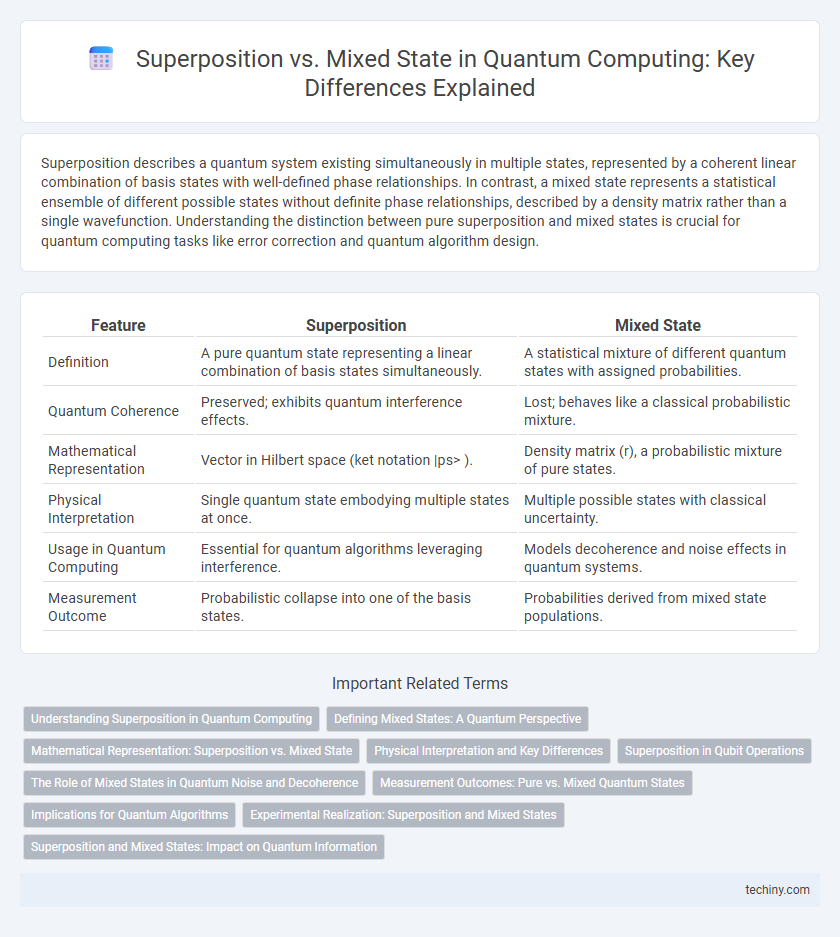Superposition describes a quantum system existing simultaneously in multiple states, represented by a coherent linear combination of basis states with well-defined phase relationships. In contrast, a mixed state represents a statistical ensemble of different possible states without definite phase relationships, described by a density matrix rather than a single wavefunction. Understanding the distinction between pure superposition and mixed states is crucial for quantum computing tasks like error correction and quantum algorithm design.
Table of Comparison
| Feature | Superposition | Mixed State |
|---|---|---|
| Definition | A pure quantum state representing a linear combination of basis states simultaneously. | A statistical mixture of different quantum states with assigned probabilities. |
| Quantum Coherence | Preserved; exhibits quantum interference effects. | Lost; behaves like a classical probabilistic mixture. |
| Mathematical Representation | Vector in Hilbert space (ket notation |ps> ). | Density matrix (r), a probabilistic mixture of pure states. |
| Physical Interpretation | Single quantum state embodying multiple states at once. | Multiple possible states with classical uncertainty. |
| Usage in Quantum Computing | Essential for quantum algorithms leveraging interference. | Models decoherence and noise effects in quantum systems. |
| Measurement Outcome | Probabilistic collapse into one of the basis states. | Probabilities derived from mixed state populations. |
Understanding Superposition in Quantum Computing
Superposition in quantum computing enables a quantum bit (qubit) to exist simultaneously in multiple states, represented mathematically as a linear combination of basis states, unlike a mixed state which is a statistical ensemble of distinct quantum states. This unique property allows quantum algorithms to perform parallel computations, dramatically enhancing processing power compared to classical bits that are either 0 or 1 exclusively. Understanding superposition is fundamental to leveraging quantum entanglement and interference, which are key to breakthroughs in optimization, cryptography, and simulation.
Defining Mixed States: A Quantum Perspective
Mixed states in quantum computing represent statistical ensembles of different quantum states, contrasting with superposition which involves coherent combinations of quantum amplitudes. Defined mathematically by density matrices, mixed states capture classical uncertainties and decoherence effects that pure states in superposition do not. Understanding mixed states is critical for modeling real-world quantum systems, error correction, and quantum information processing where noise and interactions with the environment influence qubit behavior.
Mathematical Representation: Superposition vs. Mixed State
Superposition is mathematically represented by a single state vector in a Hilbert space, expressed as a linear combination of basis states with complex probability amplitudes. Mixed states are described by density matrices, representing statistical ensembles of different quantum states with probabilistic weights, capturing classical uncertainty. While superposition encodes quantum coherence through state vectors, mixed states account for decoherence and classical mixtures using density operator formalism.
Physical Interpretation and Key Differences
Superposition represents a quantum system simultaneously existing in multiple states with coherent phase relationships, enabling interference effects crucial for quantum algorithms. Mixed states describe statistical ensembles of different quantum states without definite phase relations, reflecting classical uncertainty or decoherence impact. Key physical differences include superposition's pure state coherence versus mixed state's probabilistic mixture, influencing quantum information processing and measurement outcomes.
Superposition in Qubit Operations
Superposition in qubit operations enables a quantum bit to exist simultaneously in multiple states, represented as a linear combination of |0> and |1> , which dramatically enhances computational parallelism. This property allows quantum algorithms to perform complex calculations more efficiently than classical bits restricted to binary states. Maintaining coherence of superposed states is essential for effective quantum computation, distinguishing pure superposition from mixed states that represent statistical ensembles of quantum states.
The Role of Mixed States in Quantum Noise and Decoherence
Mixed states represent statistical ensembles of pure quantum states and play a crucial role in modeling quantum noise and decoherence in quantum computing systems. Unlike superposition, which describes a coherent combination of states, mixed states account for the loss of coherence due to environmental interactions, leading to errors in quantum information processing. Understanding mixed states enables the development of error correction techniques and noise mitigation strategies essential for robust quantum computation.
Measurement Outcomes: Pure vs. Mixed Quantum States
Measurement outcomes in quantum computing differ significantly between superposition and mixed states. Superposition states yield probabilistic results corresponding to the squared amplitudes of the quantum state's coefficients, reflecting coherent interference patterns. Mixed states represent classical statistical mixtures of quantum states, producing measurement outcomes determined by weighted probabilities without coherence, leading to fundamentally different system behavior compared to pure superposition states.
Implications for Quantum Algorithms
Superposition allows quantum algorithms to evaluate multiple possibilities simultaneously, enhancing computational speed and enabling exponential parallelism, whereas mixed states represent probabilistic ensembles of quantum states, often introducing decoherence that limits algorithmic performance. Algorithms such as Shor's and Grover's exploit superposition to achieve superior efficiency compared to classical counterparts, while mixed states necessitate error correction techniques to preserve quantum coherence and maintain algorithmic fidelity. Understanding the effects of superposition and mixed states is crucial in optimizing quantum algorithms for practical applications and mitigating noise impacts in quantum processors.
Experimental Realization: Superposition and Mixed States
Experimental realization of superposition states in quantum computing involves preparing qubits in coherent, well-defined quantum states where amplitudes interfere constructively or destructively. Mixed states, representing statistical ensembles of quantum states, are often generated through decoherence or intentional state mixing in controlled environments. Precise manipulation and measurement techniques, such as quantum tomography, are essential for distinguishing superposition from mixed states in practical quantum experiments.
Superposition and Mixed States: Impact on Quantum Information
Superposition enables quantum bits (qubits) to exist simultaneously in multiple states, allowing exponential growth in computational power through interference effects. Mixed states represent statistical ensembles of different quantum states, reflecting decoherence and loss of quantum coherence, which limits quantum information processing. Understanding and managing the transition between pure superposition and mixed states is essential for error correction and maintaining quantum computational advantage.
superposition vs mixed state Infographic

 techiny.com
techiny.com